Around 7.30 am Vij and Rajeshattan went to dress Eldho and came back to pick me and Viji at 10 am. I wike up at 10 am and we got ready for the wedding. We reached the chreiyapally (small church) around 11 am on Sunday. The wedding ceremony was going on and we joined others. It is customary that orthodox Syrian Christian women cover their head when they enter the church. So almost all women had covered their heads with their saris.
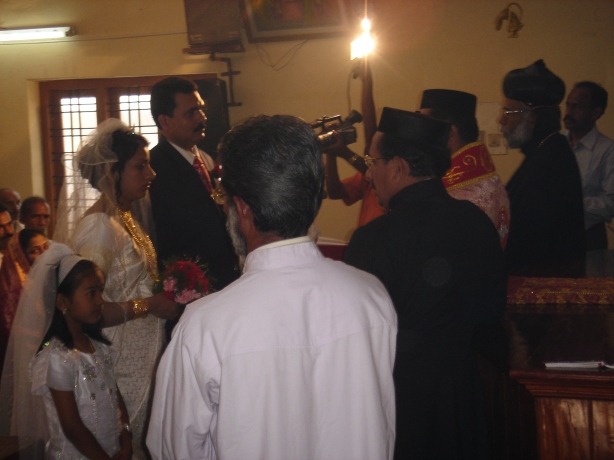
Priests preaching the couple
The ceremony took about one hour and we couldn’t attend the first ceremony which had taken place in another church for an hour. No one sat, everybody was standing and the priests were preaching to the couples in Syrian and Malayalam which was accompanied by choir singing. Though I didn’t understand much of it, Viji kept on translating and explaining things to me.
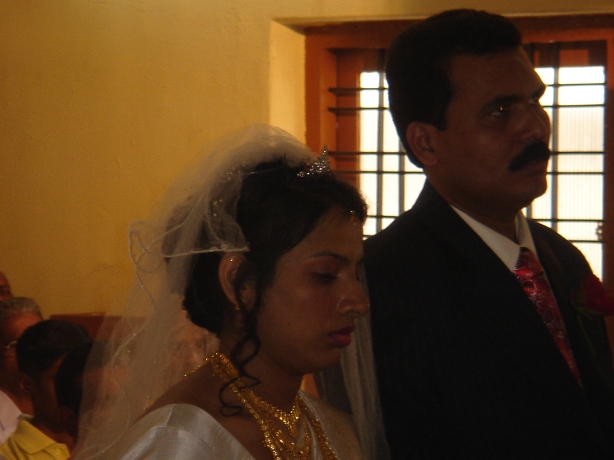
Bride and the groom hearing preaching
At last, the couple turned towards us and the bride was beautiful. Viji told me that in most Malayali weddings, the age gap between the groom and the bride will be minimum 10 years. They are very conservative in this. Any guess what is the age gap between this couple???:)
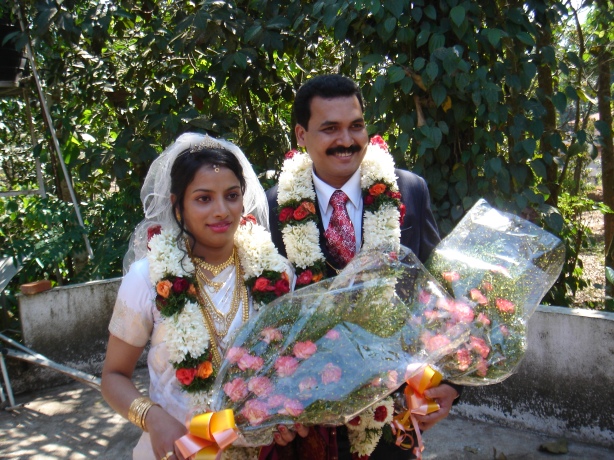
Eldho and Sheela
Eldho, groom, works in Bangalore and is a friend of Rajeshattan and Vijith. Sheela, bride, works as a nurse in Thuraif, Saudi Arabia.
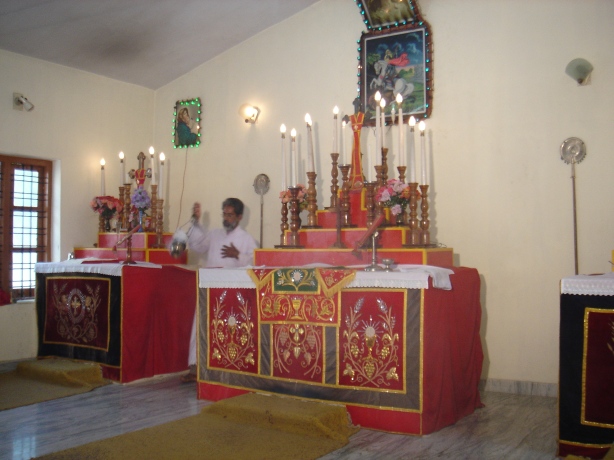
Priest performing a ritual during the wedding
Though not like Hindu weddings, Syrian Christain wedding has lot of influences from the Hindu culture. Their churches, traditions and customs have derived a lot from our tradition and culture and every ceremony clearly shows it.
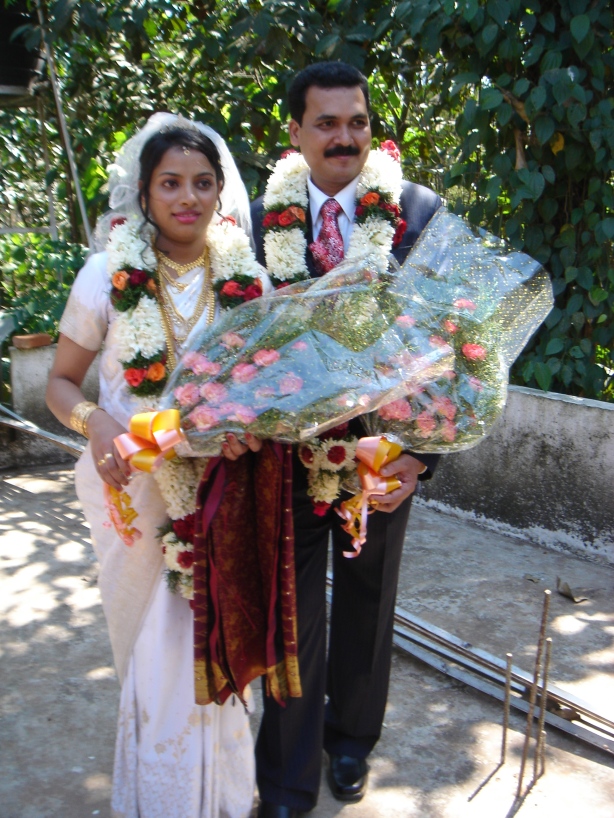
Bride and groom
There are five important ceremonies in Syrian Christian weddings.
1. Kalyanamaurappa: Arranging a match
‘Kalyanamaurappa’ means ‘arranging a marriage’ between the girl and the boy. Once the groom’s family accepts the proposal, male members from the groom’s family visit the bride’s family to fix a wedding date. Both families take a decision that the girl will come to into the boy’s family along with ‘streedhanam’ (wealth of a woman), which can include money, clothes, jewellery or property. Henceforth she will not lay any more claims on her father’s wealth. Once an agreement is reached, the two eldest male members from each family hold hands in a symbolic clasp. An ‘angavastram’ (white cloth) covering their hands, seals the contract. The engagement is announced at the respective churches for three consecutive Sundays in the presence of the community and the families of the bride and groom. On the third Sunday, the bride and groom go to their respective churches for confession and to partake in the Holy Communion.
2. Madhuramvekal: Pre-wedding ceremony
This ceremony is held in the respective homes of the bride and the groom, a day prior to the church wedding. Barring a few differences, the ceremonies are similar.
The groom sits facing the east, while a barber cuts his hair and shaves off his beard. The groom’s eldest sister or female cousin anoints his hair with oil.The groom’s brother-in-law then escorts the groom for his regular bath ensuring that he does this from the westerly direction. The groom returns from the easterly direction, sheltered under an umbrella, held by the brother-in-law. On his arrival, all the ladies clap their hands and cheer him. This is called the ‘korava’, traditionally considered very auspicious throughout Kerala.
In the bride’s home, she is made to wear a simple sari and her brother’s wife performs the rituals of anointing her with oil and taking her for her bath in the same manner as done for the groom. After her bath, the bride changes into a resplendent silk sari, wears traditional jewellery; adorns her hair with flowers and puts on a gold chain with a cross on it.
After the ‘korava’ the bride and groom in their respective homes, heads covered, sit on a chair, which has been covered with a white cloth and are blessed by the priest. A sweet called ‘madhuram’ (banana slices soaked in sweet Palmyra palm juice) is brought to be blessed by the priest. After the blessing, the sweet is given to the bride and the groom by the mother or grandmother.
3. Mantra Kodi: Preparing the’ taali’
The sari, which the groom will present to his bride in church the next morning, is called the ‘mantra kodi’. The night before the church ceremony, strands of thread are drawn from this sari by the groom’s sister and twisted to form a cord. Taali, a leaf shaped gold pendant with a cross inscribed on it, is tied on this cord.
4. Church ceremony: Holy Matrimony
On the day of the wedding, the priest visits each home separately and blesses the bride and the groom. The groom carries the sari for the bride, the ‘taali’ and two wedding bands. After the blessing, the bride and the groom step out of their homes, preceded by a young girl holding a ‘diya’ or lamp. The bride wears cream coloured Kerala sari. In the church the priest officiates and after the sermon, the couple exchange wedding bands. All through the ceremony the bride’s sister stands behind her. Vows are exchanged and the groom ties the ‘taali’ to the bride. During the tying of the ‘taali’, the bride’s sister is replaced by the groom’s sister. The ‘mantra kodi’ is placed on the bride’s head by the priest and blessed. Later, the bride puts the sari on her left hand. The same sari is worn by her for the reception. The couple joins hands and is announced man and wife.
5. Reception: Post wedding celebrations
The reception is a modern day concept, borrowed from the West and is basically a celebration of the wedding. The families involved host a grand dinner and the newly wed couple is introduced to the relatives and guests.

Vij and Rajeshattan
After the wedding we headed towards the valiayapalli nearby, which is famous for a miracle. People say that the priest of this church disappeared after drowning in a well. When people tried to fish out his body, it was not found in the well.
No comments:
Post a Comment